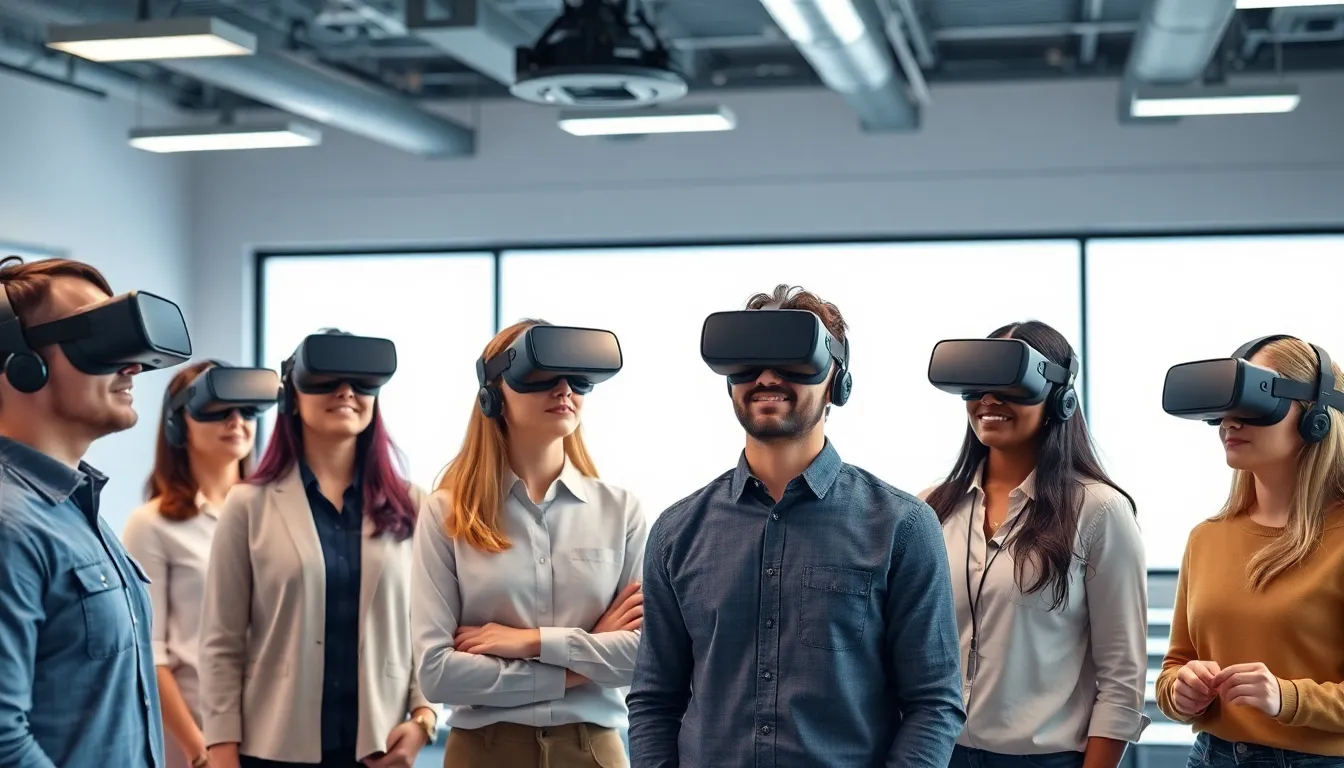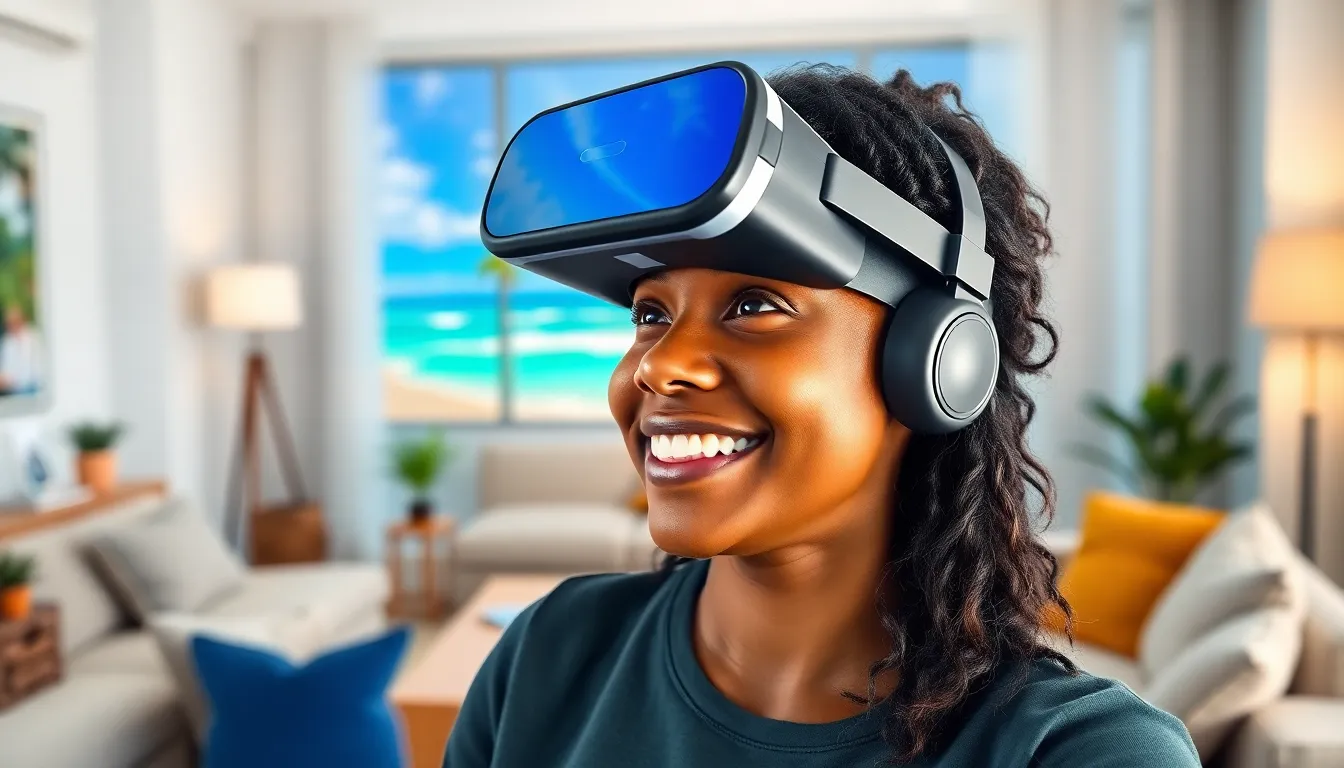Imagine slipping on a headset and instantly finding yourself on a tropical beach, sipping a piña colada without ever leaving your living room. That’s the magic of virtual reality solutions. They’re not just for gamers anymore; these immersive experiences are transforming industries from education to healthcare, making learning and training more engaging than ever.
Table of Contents
ToggleOverview of Virtual Reality Solutions
Virtual reality solutions create immersive experiences that engage users across various industries. Applications span education, healthcare, real estate, training, and entertainment, showcasing the versatility of VR technology. In education, VR enhances learning by allowing students to explore complex subjects in interactive environments.
Healthcare professionals benefit from VR simulations that replicate real-life scenarios. Medical students practice surgical techniques, while therapists use VR to treat phobias or anxiety disorders. The training industry employs VR to provide safe environments for high-risk operations, such as aviation or emergency response training.
Real estate showcases properties through virtual tours, allowing potential buyers to explore homes remotely. These immersive walkthroughs increase engagement and provide a comprehensive view of listings without physical visits. Entertainment also embraces VR, offering users unique gaming experiences that feel real and personalized.
Several industries utilize VR solutions for skill development. Companies incorporate VR training modules to reduce errors and improve retention rates. Organizations that invest in VR solutions often report higher employee satisfaction and performance.
The future of virtual reality promises further advancements, with ongoing research driving innovation. Companies recognize the value of VR in enhancing user experiences, making it a critical tool for modernization. Embracing these technologies leads to increased efficiency and improved outcomes across sectors.
Benefits of Virtual Reality Solutions

Virtual reality solutions provide significant advantages across multiple industries. Their impact can transform user experiences and enhance training methodologies.
Enhanced User Experience
Immersive environments create memorable interactions. Users feel present in simulations, leading to higher engagement levels. VR experiences stimulate senses, making activities, such as virtual property tours or gaming, feel realistic. Companies leveraging VR notice increased customer satisfaction, with studies showing a 30% rise in engagement rates during virtual experiences. Engaging content becomes vital for marketing strategies, allowing brands to stand out. Businesses gain a competitive edge by delivering compelling user experiences that foster loyalty.
Improved Training and Education
Training efficacy improves with VR’s interactive nature. It allows professionals to practice skills in safe, controlled environments. For instance, medical personnel use simulations for complex procedures, increasing retention rates. Schools incorporate VR to enhance learning through real-world experiences. These interactive environments cater to diverse learning styles, benefiting students when acquiring new knowledge. Over 60% of educators report improved student performance with VR integration. Virtual reality enhances workforce capabilities while ensuring readiness for real-world scenarios.
Applications of Virtual Reality Solutions
Virtual reality solutions apply across various industries, driving innovation and enhancing user experiences.
Gaming and Entertainment
Gaming and entertainment sectors embrace virtual reality as a tool for creating immersive experiences. Gamers find engagement levels significantly elevated with VR, leading to more captivating gameplay. Developers design interactive environments that stimulate realism, allowing players to explore fantasy worlds like never before. Reports indicate that VR gaming increases retention rates, making users return more frequently. Entertainment companies also utilize VR for virtual concerts, enabling audiences to enjoy events from anywhere in the world. This fusion of technology and creativity positions VR at the forefront of interactive entertainment.
Healthcare and Therapy
Healthcare professionals employ virtual reality solutions to improve training and therapy methods. Simulated environments provide safe spaces for trainees to practice procedures without risk. Studies show that more than 60% of healthcare workers feel VR training enhances their skill retention. Therapists also use VR for patient treatments, effectively assisting individuals in overcoming phobias and managing anxiety. This technology offers a controlled setting, allowing patients to confront challenges gradually. With increasing adoption in medical education and patient rehabilitation, VR revolutionizes healthcare practices.
Real Estate and Design
Real estate ventures incorporate virtual reality to transform property viewing experiences. Prospective buyers can take immersive virtual tours, exploring spaces without physical presence. Agents find that VR tours decrease property time on the market, as interested individuals engage with listings more interactively. Design professionals access VR to visualize projects before ground-breaking, enhancing collaboration with clients. They envision modifications in real-time, leading to better decision-making. As a result, integrating VR in real estate and design enriches both sales strategies and client satisfaction.
Challenges in Implementing Virtual Reality Solutions
Implementing virtual reality solutions presents multiple challenges that organizations must navigate. Understanding these obstacles helps ensure successful adoption of VR technology.
Technical Limitations
Technical limitations impact the effectiveness of VR solutions. Hardware constraints hinder performance, as many devices experience latency or require high processing power. Compatibility issues may arise with existing software, complicating integration. Content development poses another challenge, as creating immersive VR experiences requires specialized skills and significant time investment. Users may also encounter motion sickness due to inadequate frame rates or poor calibration, affecting overall satisfaction.
Cost Considerations
Cost considerations play a crucial role in adopting VR solutions. Initial investments can be substantial, encompassing hardware, software, and development expenses. Ongoing maintenance further contributes to long-term costs. Smaller organizations may struggle to allocate budgets for VR, limiting access to advanced technology. Despite the potential return on investment, such as increased engagement or improved training outcomes, financial barriers remain a significant hurdle for many.
Future Trends in Virtual Reality Solutions
Emerging trends in virtual reality (VR) solutions indicate significant advancements across multiple sectors. Companies increasingly integrate VR into everyday operations, enhancing productivity and creativity among teams. Innovations in hardware, such as lighter, more affordable headsets and improved graphics, facilitate widespread adoption.
The rise of social VR offers platforms for collaborative experiences, allowing users to interact in shared virtual spaces. Schools and universities innovate by creating immersive learning environments that promote engagement and retention. Educational institutions increasingly leverage VR for subjects like history and science, helping students visualize complex concepts.
Healthcare continues to evolve through VR, with medical professionals using simulations for surgical training and patient therapy. Recent data shows that 70% of healthcare workers report improved skills through VR-based learning. Increasingly, hospitals embrace VR tools for pain management, offering patients soothing environments during treatments.
Real estate also benefits from VR advancements, enabling virtual tours that expedite property sales. A recent survey indicated a 40% increase in buyer interest for listings featuring VR presentations. In marketing, brands utilize interactive VR experiences to captivate consumers, enhancing brand loyalty and engagement rates.
Challenges remain, particularly regarding content creation and infrastructure. As organizations prioritize VR strategy, addressing budget constraints becomes essential for developing robust solutions. Support from industry leaders and ongoing technological improvements can mitigate these obstacles, making VR accessible to a broader audience.
Investments in VR technology promise substantial returns, particularly through enhanced training programs. Statistics reveal that companies utilizing VR report a 30% boost in employee performance. Continuous innovation will likely drive VR’s integration into more areas, reshaping future landscapes of business, education, and healthcare.
The evolution of virtual reality solutions is reshaping industries and enhancing user experiences in unprecedented ways. As VR technology becomes more accessible and affordable, its applications are expanding beyond entertainment into critical sectors like education and healthcare. Organizations that embrace these innovations are likely to see significant improvements in engagement and training outcomes.
While challenges remain in implementation and costs, the potential benefits far outweigh the hurdles. Continued advancements in VR will undoubtedly lead to even more immersive experiences and practical applications. As the landscape evolves, staying ahead of the curve with VR solutions will be essential for businesses aiming to thrive in a competitive environment.


